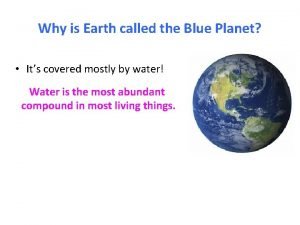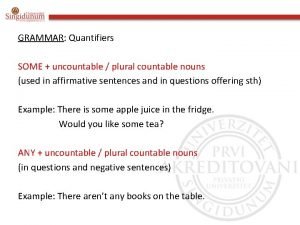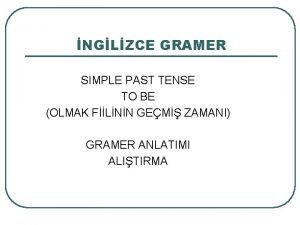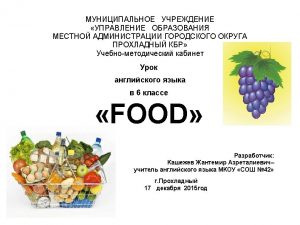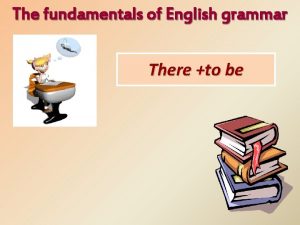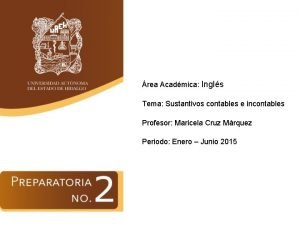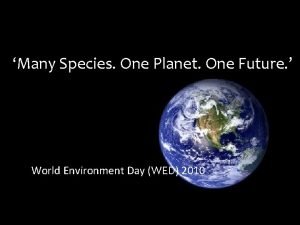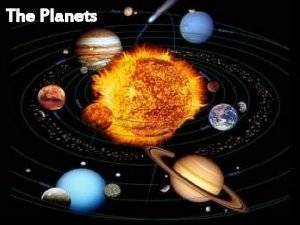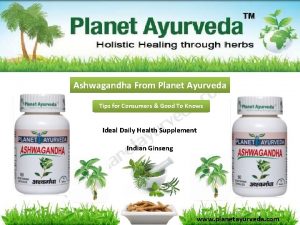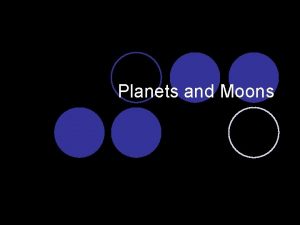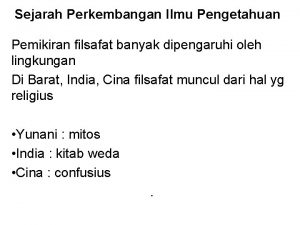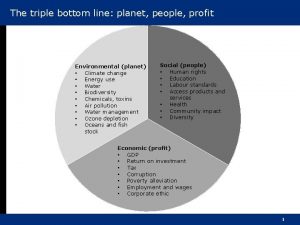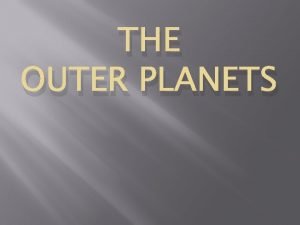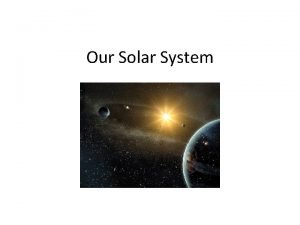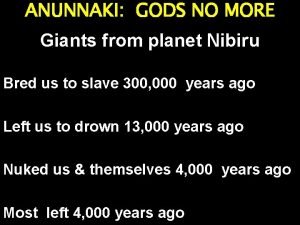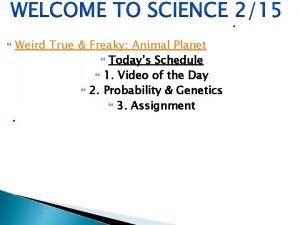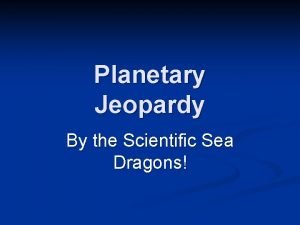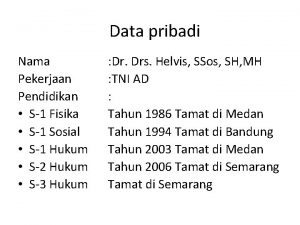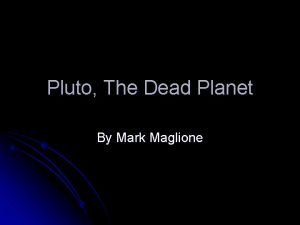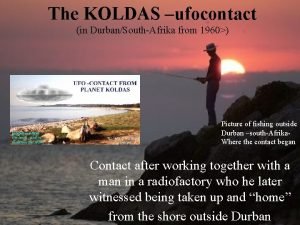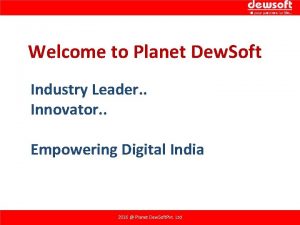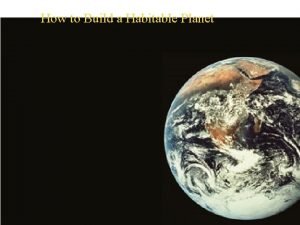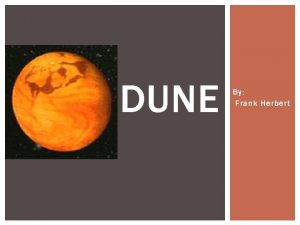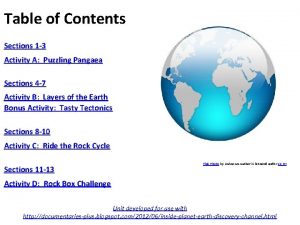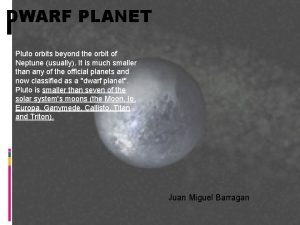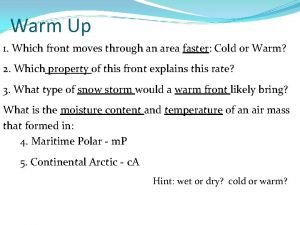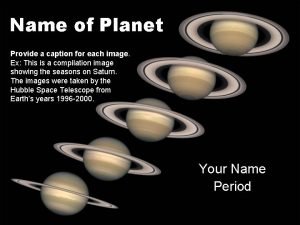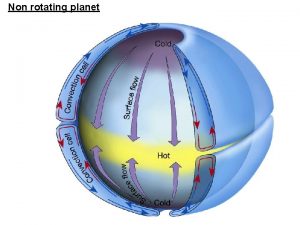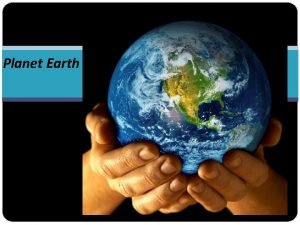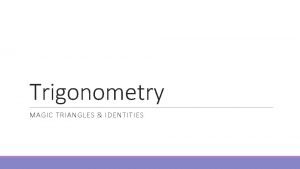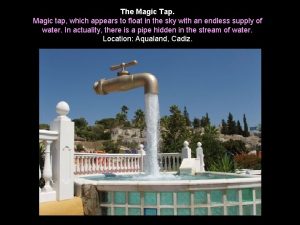If there is magic on this planet it

































































- Slides: 65

If there is magic on this planet it is contained in water. LOREN EISLEY

Aquatic Biodiversity (8) Water covers ¾ of the Earth’s Surface: 71% saltwater 2. 2% freshwater The global ocean is one continuous body of water, it is divided into 4 large areas (Atlantic, Pacific, Arctic, and Indian Oceans). The Pacific is the ______ Most freshwater is trapped in _________. Liquid water is found (listed from most to least) in: 1. 2. 3. 4. 5. 6.

Aquatic Life Zones Aquatic life zones are equivalents to biomes on land. The key factors determining biodiversity in aquatic systems are: 1. 2. 3. 4. 5. Aquatic life zones are categorized into two major types: 1. Saltwater or marine which include: oceans, estuaries, coastal wetlands, shorelines, coral reefs, and mangrove forests. 2. Freshwater which include: lakes, rivers, streams, and inland wetlands.

Oceanic Life Zones Coastal Zone: that region in which tides expose the sea bottom for some part of each day. The habitats are alternately submerged under salt water and waterlogged for hours and then exposed to the air and dried out for hours. ________. Pelagic Zone: _______________, this contains the vast open waters of the ocean. Two subdivision are recognized: 1. Neritic Zone: the water overlying the continental shelf. These waters usually extend to a depth of 600 ft. _______________ 2. Oceanic Zone: The region of the sea extending from the edge of the continental shelf, over the continental slope, and over ocean floor. It is characterized by darkness and tremendous pressure. Vertical life zones are significant here.

Further Divisions are Based on Light Photic (Euphotic) zone: The top of the water column as far down as ______________________________________. Aphotic zone: the remainder of the water column below the euphotic zone. Food chains usually begin with __________________________________. The bathyal zone is the dimly lit transition between the photic and aphotic zone. The abyssal is the dark zone all the way to the ocean floor. ______: This zone contains all the habitats of the sea bottom. Organisms may live within the ________________________ bottom material or on its surface. _______________________________________________

Sea level 50 100 Continental shelf 200 500 Bathyal Zone 1, 000 1, 500 ___________________________ ___________________________ _____________. 0 5 10 20 15 Water temperature (°C) Photosynthesis 0 Euphotic Zone Estuarine Zone Depth in meters 2, 000 Abyssal Zone 3, 000 4, 000 5, 000 10, 000 25 Twilight Coastal Zone Open Sea Sun 30 Darkness High tide Low tide

Species Live in Specific Depths Saltwater and freshwater life zones contain several major types of organisms: 1. Plankton: Weak swimming, free floating organisms. A. ___________ (drifting Plants): Photosynthesizing groups of algae. With the addition of rooted shoreline plants, these are ____________________. B. __________ (drifting animals): Primary consumers (herbivores) and secondary consumers that include protozoa and jellyfish. 2. Nekton: strongly swimming consumers such as fish, turtles, and whales. Top consumers in the aquatic ecosystem 3. Benthos: consist of bottom dwellers such as oysters, lobsters, clams, worms, and crabs. Primary consumers and decomposers 4. Decomposers: mostly bacteria that recycle organic material and release nutrients to be used by aquatic primary producers.

Saltwater ecosystems are irreplaceable reservoirs of biodiversity and provide major ecological and economic services.

Marine Ecosystem The coastal zone is the warm, nutrient rich, shallow water that extends from the high-tide mark on land to the gently sloping, shallow edge of the continental shelf. 1. Makes up less than 10% of the ocean’s area. 2. Contains _______ of all marine species and is the site of most commercial fisheries. 3. High NPP (Net primary productivity) a lot of sunlight and nutrients. A wetland is a land area that is saturated with water and are considered the ________________of all ecosystems, serving as home to a wide range of plant and animal life. They includes Estuaries, marshes, bogs, swamps, coral reefs, mangrove forests and seagrass beds.

NPP and GPP NPP = GPP - R R is the amount of energy used by primary producers for cellular respiration and maintenance of existing tissues. Besides the High NPP of wetlands they have three other important jobs: 1. _________________________________ 2. _________________________________ 3. _________________________________

Estuaries form a transition zone between river and ocean environments where salty and fresh water combine to form _______. Phytoplankton are key primary producers in estuaries. Three of the main challenges of life in an estuary: 1. ________________ 2. ________________ 3. ___________________________________ The inflows of both sea water and fresh water provide high levels of nutrients in both the water column and sediment, making estuaries among the __________________ habitats in the world.

Human Impact on Estuaries provide habitats for many fish nurseries and migratory bird populations. Just one acre of estuary provides $75, 000 worth of _______, and has a value of about $83, 000 when recreation and fish for food are included. The banks of many estuaries are amongst the most heavily populated areas of the world, with about 45% of the world's population living here. 1. ______________________________________ 2. ______________________________________ 3. ______________________________________

Mangrove Forests Mangrove forests are coastal wetlands of salt loving trees Mangrove swamps: 1. Protect the land from soil erosion and the effects of storms. 2. Act as a form of _________, naturally filtering out industrial and human waste. 3. They provide a _________ for some 2000 species of fish, invertebrates, and plants. 4. Near shore ___________is responsible for loss of many mangrove forests. 5. Mitigation projects have started to create new wetlands.

Kelp Forests Kelp forests are underwater areas with a high density of kelp and occur throughout the world Kelp forests provide a unique three-dimensional habitat for marine organisms: 1. It reduces the effects of __________ 2. It provides _______________ 3. It serves as a _____for many invertebrates 4. ____________________ Overfishing near shore ecosystems often contributed to kelp forest degradation by: 1. Releasing herbivores from their normal population regulation and result in the over-grazing of kelp. 2. Killing the sea otter to increase abalone harvest also increased urchin populations that eat kelp. The implementation of ______________is one management strategy useful for addressing such issues

Coral Reefs Coral reefs are underwater structures made from _________secreted by corals (hard corals). Reefs grow best in: 1. ______________________________________ 2. Often called "rainforests of the sea", they occupy less than 0. 1% of the world's ocean surface, yet they provide a home for 25% of all marine species. 3. They are the most _______ of all marine ecosystems so like their terrestrial counterpart (tropical rain forests) with high biodiversity comes low nutrient levels. Nutrients tied up in the organisms. 4. To overcome living in nutrient poor waters, corals live in a symbiotic relationship with _______________________

Important ecological and economic services 1. Moderate atmospheric temperatures (bind carbon dioxide to build their skeletons = carbon sink) 2. Act as natural barriers protecting coasts from erosion 3. Provide habitats 4. Support fishing and tourism businesses 5. Provide jobs and building materials (the sand rubble they leave on the shores can be used to make concrete) The Brain Coral

Seagrass Beds Seagrasses form extensive beds or meadows of underwater grasses. Seagrass herbivory is a highly important link in the food chain. Humans ________over shallow seagrass areas and destroy plants and kill animals. Open Sea Separated into 3 major zones: 1. The euphotic zone: 40% of the world’s photosynthesis. Nutrients levels are low but dissolved oxygen is high. 2. Bathyal zone: dimly lit middle zone. Contains zooplankton (don’t photosynthesize) and smaller fish that migrate to the surface to feed. 3. Abyssal zone : Dark and cold zone. It is high in nutrient due to _________(dead and decaying organisms sinking from above) and low in oxygen. The marine snow allows the deep bottom to support large numbers of species even though there ____________.

Ocean currents A current is like a vast river within the ocean, flowing from one place to another. These currents are caused by differences in __________________. These current redistribute heat. The Northern Hemisphere is dominated by land the Southern Hemisphere by ocean. 1. Temperature differences between summer and winter are more extreme in the north because land warms and cools faster than water. 2. Heat is transported from the equator to the poles.

Great Ocean Conveyor Belt In the deep ocean, the predominant driving force is differences in density (_____________). Warm water moves north in the Atlantic Ocean and loses heat to the atmosphere and sinks (down welling). Cold water from Antarctica enters the Indian and Pacific oceans where the atmosphere warms it and the water comes to the surface (upwelling). _______________________________________________________________________________.

The Gulf Stream The _____________________, are a powerful, warm, and swift Atlantic ocean current that originates at the tip of Florida, and follows the eastern coastlines of the United States and Newfoundland before crossing the Atlantic Ocean. The Gulf Stream causes the __________________________________________________________________

Lakes are large natural bodies of standing freshwater formed from precipitation, runoff, and groundwater seepage. In freshwater aquatic environments _____________levels limit the amount of primary production. Lakes are divided into four zones based on depth and distance from shore __________________ Littoral

Littoral Zone A shallow area near the shore, to the depth at which rooted plants stop growing. Ex. Animals: frogs, snails, insects, fish, Ex: plants: cattails, rushes and water lilies. _____________, and settlement often disrupts breeding habitats for littoral zone species. For example, many turtles are killed on roads when they leave the water to lay their eggs in upland sites. Fish can be negatively affected by ________________________i n shallow water. An equally serious problem is the tendency to stabilize lake or river levels with dams which stop the _____________________________________.

Limnetic Zone The limnetic zone is the well-lit, open surface waters in a lake, away from the shore. This is the main _____________. This zone produces the _______that support the lake's consumers. This area is occupied by a variety of phytoplankton, consisting of algae and cyanobacteria, as well as zooplankton, small crustaceans, and fish. Some large fish spend most of their time here, with occasional visits to the littoral zone to feed and breed.

Profundal and Benthic Zone The profundal zone is located _____________________. This is typically below thermocline The profundal zone is part of the aphotic zone. Without plants this zone is ___________. The benthic zone is the bottom of the lake. It is inhabited by decomposers and some fish. It is nourished by dead matter sinking from the littoral and limnetic zones.

Spring and Fall Turnover Thermal Lake stratification is the separation of lakes into three layers based on temperature: 1. Epilimnion - top of the lake. 2. Metalimnion (or thermocline) - middle layer that may change depth throughout the day. 3. Hypolimnion - the bottom layer. In the winter ice forms and the entire lake becomes one temperature (4 o C) and acts as one layer and _____. In the spring the warming/melting of the ice layer at the surface allows winds and storms to create a ______ with little difficulty. Oxygen and nutrients get distributed throughout the water column as the water mixes. In the summer the lake becomes stratified and the _________________________ Hypolimnion Epilimnion Thermocline Hypolimnion In the fall the temperatures begin to drop, the surface layer becomes more dense and we get ___________.

Lake Nutrients Eutrophication: (well nourished body of water) A natural nutrient enrichment mostly __________________________ from the surrounding land. High NPP Oligotrophic: (________) A lake that is low in nutrients and will have very clear water. Low nutrients reduce organisms like _____ that make the water murky. Low NPP. Cultural eutrophication: (_______) near urban areas, human activities increase nutrients above the natural nutrient enrichment. Nitrogen-phosphorus containing substances make their way to bodies of water from: _______________________________________. Cultural Eutrophication is considered pollution. Because this gets into our water supply from runoff, etc. , and is something that is not normally in the water, Oligotrophic lake

Problems with Cultural Eutrophication During hot weather and drought, this nutrient overload produces dense growths or ______of organisms. The water is cloudy and usually resembles pea soup because of the ________________ that are supported by the nutrients. These blooms reduce lake productivity and fish growth by _________________ that support fish. When the blooms die their decomposition by ______________. This can kill fish and other aerobic animals. ______ If nutrients continue to be added the water loses enough DO to allow anaerobic organisms to take over. These organisms produce _______________________________.

Preventing, Reducing and Fixing Cultural Eutrophication Prevention and reduction techniques: 1. Use expensive waste treatment to remove nitrates and phosphates before waste water enters lakes and oceans. 2. Banning or limiting phosphates in household detergents and cleaners. 3. Use soil conservation to reduce soil nutrient runoff. Fixing Eutrophication (IPM) 1. Use herbicides and algaecides to kill plants 2. Deepen lakes to increase area for animals to live and increase oxygen content. 3. Artificially oxygenating the water by pumping in fresh oxygen. 4. Introducing competitors or insects that eat the plants. 5. Mechanically remove excess weeds and plants. La Jolla, San Diego: Harmful algal bloom (HAB) events can be very bad for us. People who eat shellfish from waters experiencing toxic blooms can become very ill and can even die.

Flowing Water: Stream and Rivers When precipitation does not sink in the ground into becomes surface water that flows in a stream. A watershed or drainage basin is the land that delivers runoff, sediment and dissolved substances to a stream. Ecological Services of Rivers There are 3 zones in the downhill flow of water: 1. Source zone: Narrow channels of cold, clear water. • Deliver nutrients to sea to help 2. Transition zone: Deeper, wider channels of slower moving waters. Waters are warmer and murky. • Deposit silt that maintains deltas sustain coastal fisheries • Purify water 3. Floodplain zone: Slower-moving water, less oxygen, warmer temperatures, and lots of algae and cyanobacteria. • Renew and re-nourish wetlands • Provide habitats for wildlife

Inland Wetlands Inland wetlands are lands covered with freshwater all or part of the time. A marsh is a type of wetland that is dominated by herbaceous rather than woody plant species. Marshes can often be found at the edges of lakes and streams. Freshwater marshes make up the _______________________________________ A swamp is a wetland that is forested. Many swamps occur along large rivers where they are critically dependent upon natural water level fluctuations. A bog is a mire that accumulates ____ (a brown, hydrocarbon containing, soil-like that is widely cut and dried for use in gardening and as fuel). A floodplain or flood plain is an area of land adjacent to a stream or river that experiences flooding during periods of high discharge.

Ecological Services of Wetlands Provide free ecological and economic services 1. Filter and degrade ___________________________. 2. _________________________________________________________________________ 3. Help to replenish streams and ________________________. 4. Increase biodiversity by supplying ______________________. 5. Food (berries, fish and shellfish) and timber 6. Recreation areas Freshwater wetlands are categorized into marshes, bogs, swamps etc. based on three properties: 1. ______ is the study of the movement, distribution, and quality of water it contains. 2. The ______________that constitutes the shores and bottom of wetland. 3. The composition of species or _____ of living organisms (especially plants) that live in the area.

Case Study: the Florida Everglades The world’s largest ecological restoration project involves trying to undo some of the damage inflicted on the Everglades by human activities. 1. 90% of park’s wading birds have vanished. 2. Other vertebrate populations down 75 -95%. 3. Large volumes of water that once flowed through the park have been diverted for crops and cities. 4. Runoff has caused noxious algal blooms. Loss of wetlands has led to _____________________ Lost due to ____________________________________________

Degrading Freshwater Systems: Human Impact Human activities threaten biodiversity and disrupt ecological and economic services provided by freshwater lakes, rivers, and wetlands. Threats 1. The creation of __________________(40% of rivers) blocks migration routes for fish and disrupts habitats. 2. _______________for human use shrinks and degrades habitats. 3. Runoff from ____________________hurts water quality. 4. Draining of wetlands for development of cities and farm depletes habitats. 5. Overexploitation and pollution threaten groundwater supplies. 6. __________________can harm native animals and plants. 7. Global warming may lead to devastating floods and droughts. Solutions 1. Restrict the construction of dams. 2. Provide incentives for farming business to reduce the use of pesticides. 3. Establish protected wetlands areas. 4. Regulate water withdrawal for human use.

By treating the oceans with more respect and by using them more wisely, we can obtain more from these life-supporting waters while also maintaining healthy and diverse marine ecosystems BRIAN HALWEIL

Sustaining Aquatic Biodiversity (11) Biodiversity of the oceans follow three general patterns: 1. Greatest marine biodiversity occurs in ______________________________________. 2. Biodiversity is higher _______then in the open ocean because the coast has __________________. 3. Away from the coast biodiversity is higher in the bottom region than the surface because the bottom has __________________. Human activities are destroying aquatic habitats (H. I. P. P. C. O. ) H. Destruction of coral reefs, mangrove swamps, coastal wetlands and rivers where ______________. Trawler boats drag large nets that tear up the bottom of the ocean to catch scallops, shrimp and other fish. Dams and excess water withdrawal from rivers and lakes destroy freshwater habitats. Many inland wetlands have been drained or filled for agriculture or (sub)urban development.

Area of ocean before and after a trawler net, acting like a giant plow, scraped it. I. Hundreds of harmful invasive species have been accidentally or deliberately introduces into aquatic systems. These invaders are responsible for 2/3 of the fish. _________________________________________________. Lake Victoria has lost their endemic fish species to large introduced predatory fish. Reasons for Lake Victoria’s loss of biodiversity: 1. Deliberately introduction of Nile perch. 2. Lake experienced algal blooms from nutrient runoff. Reduction of fish that eat algae. 3. Invasion of water hyacinth has blocked sunlight and deprived oxygen. 4. Nile perch is in decline because it has eaten its own food supply.

Invaders of the Great Lakes The native distribution of the species is in the Black Sea. _______have become an invasive species in the Great lake area of north America. It is believed they were inadvertently introduced into the lakes in the ballast water of ocean-going ships traversing the St. Lawrence Seaway Zebra mussels: 1. Damage harbors and waterways, ships and boats, and water treatment and power plants. 2. The zebra mussels also cling on to pipes under the water and clog them. In the Erie Canal, which connects the ocean to the Great Lakes, ________ came in and depleted the fish. The National Invasive Species Act (NISA) 1996. The official purpose is: “To provide for ballast water management”.

P. P. Population growth equals more pollution. 1. Each year _____ items dumped on beaches threaten marine life. 2. Runoff brings pollutants to aquatic ecosystems as well as nutrients that can lead to ___________. 3. Also ________________ matter make water unsafe. C. Climate change causes sea levels to rise destroying coral reefs, swamp some low-lying areas and drowned coastal wetlands leaving many people homeless and landless. . Coral reefs are fragile ecosystems: Changes in the ocean will cause corals to bleach (_________________). Without their algae, the corals will starve to death and turn white, hence coral bleaching. 1. Corals are very sensitive to __________. They are under threat from climate change 2. ___________(excess CO 2 dissolves in the ocean creating carbonic acid reducing p. H) 3. Blast fishing, cyanide fishing and harvesting for aquarium fish, 4. Harmful ________, including urban and agricultural runoff and water pollution, which can harm reefs by encouraging excess algal growth and excess sediment.

O. The human demand for seafood is outgrowing the sustainable yield of most ocean fisheries. Industrialized fishing fleets vacuum up fish faster than they can replenish. They fish for one but catch many. 1. Their large nets and long lines of hooks capture non target fish called _____ 2. About 1/3 of the fish by weight are by-catch and are thrown back dead or dying. 3. _________________________________. Fishing techniques: 1. Purse-seine fishing: A large purse-like net is put into the ocean and is then closed like a drawstring purse to catch tuna. 2. Long-line fishing: Lines are put out that can be up to 80 miles long w/ thousands of baited hooks on them. These are left out free-floating for days and then the boat comes back and picks them up. 3. Drift-net fishing: Each net hangs as much as 50 feet below the surface and up to 34 miles long. Anything that comes into contact with these nearly invisible nets are entangled. ______________________________________ _______________________

Aquaculture is the farming of aquatic organisms. aquaculture include fish farming, shrimp farming, oyster farming, algaculture (such as seaweed farming), and the cultivation of ornamental fish. Aquaculture concerns include: 1. Waste handling 2. _________________ 3. Using ___________to feed more marketable carnivorous fish. 4. Many farmed raised fish have large amounts of ______________________________. 5. Many raised fish (especially salmon) are Genetic modified (GMOs) and can escape and ________________. Aquaculture Benefit include: 1. ____________________________ 2. ___________________________ 3. ___________________________

Degrading Marine Systems: Human Impact Human activities threaten aquatic biodiversity and disrupt ecological and economic services provided by saltwater systems. Major threats to marine systems 1. Coastal development: destroys and pollutes coastal habitats 2. Overfishing 3. Runoff of nonpoint source pollution: fertilizers, pesticides, livestock waste 4. Point source pollution: Sewage from cruise ship and oil spills 5. Habitat destruction 6. Introduction of invasive species 7. Climate change from human activities: warmer ocean temperatures (coral bleaching) and ocean acidification (Ocean acidification is the ongoing decrease in the p. H of the Earth's oceans, caused by the uptake of carbon dioxide (CO 2) from the atmosphere to form carbonic acid CO 2 + H 2 O ----> H 2 CO 3

Laws, Treaties, Money, Sanctuaries and Reserves Protect Marine Species. Clean water acts: 1. ___________: (SDWA, 1974) set maximum contaminant levels for pollutants in drinking water that have adverse effects on human health. Ex: Lead 2. _________: (CWA, 1972) set maximum permissible amounts of water pollutants that can be discharged into waterways. Purpose is to make surface waters swimmable and fishable. Animal Protection Acts 1. _______ (the Convention on International Trade in Endangered Species: 1975) 2. __________of 1973 it was designed to protect critically imperiled species from extinction as a "consequence of economic growth and development. " The ESA "was to halt and reverse the trend toward species extinction, whatever the cost. “ 3. ______________of 1972 (MMPA) "any act of pursuit, torment or annoyance which has the potential to either: a. injure a marine mammal in the wild b. disturb a marine mammal

Economic Incentives to Protect Aquatic Biodiversity For example: Sea turtle tourism brings in 3 times more money than does the sale of turtle meat, leather and eggs. By international law a country has control over their shoreline waters that extends 200 miles from shore. Ocean water further out is considered high seas. Many countries have set up marine protected areas, sanctuaries and reserves (MPAs)in these waters to help protect marine species. Their goal is to reduce or stop fishing in these areas and increase biodiversity. ___________describe projects or programs intended to offset known impacts to an existing historic or natural resource such as a stream, wetland or endangered species Example: _____________________________________________________________________________.

The benefits of working with nature’s water cycle, rather than further disrupting it, are too compelling to ignore. SANDRA POSTEL

Is There Enough Water? (13) Freshwater is of major importance to all living things 1. Up to 60 percent of the human body is water. 2. Each day humans must replace 2. 4 liters of water (1/2 a gallon), some through drinking and the rest taken by the body from the foods eaten. The United States in uses about 1, 430 gallons per day person (Largest per capita in the world). The lowest per capita use occurs in _______ What do we use water for: 1. Most water is used for _____________ 2. Industry (for _____________plants) 20% 3. _________________(at home) 10%

We are using available freshwater unsustainably by wasting it, polluting it, and charging too little for this irreplaceable natural resource (_________________). Only about 0. 024% of the earth’s water supply is available to us as liquid freshwater Access to water is 1. A global health issue: __________do not have sufficient access to clean water. The WHO estimates that 1. 6 million people die from waterborne diseases each year about 1 every 2 minutes (90% children) 2. An economic issue: ___________________________. 3. A women’s and children’s issue: They are usually tasked with finding and carrying water. 4. A national and global security issue: Tension in the Middle East for shared water resources. Even here Arizona and California/Colorado River. 5. Environmental issue: Excessive withdrawal of water from rivers and aquifers and pollution of water result in a lower water table, shrinking rivers and lakes, loss of wetlands, loss of fish, etc.

Groundwater Some precipitation infiltrates the ground and is stored in soil and rock (groundwater). 1. The soil close to the Earth’s surface hold little moisture. 2. Below a certain depth (varies from place to place) is the ___________where the spaces between the soil particles are completely filled with water. 3. The top of this zone is the __________, which fluctuates throughout the year. Deeper down are underground water storage areas called aquifers. An aquifer is an underground layer of water-bearing permeable rock or unconsolidated materials (gravel, sand, or silt) from which groundwater can be extracted using a water well. The water gets __________as it sinks into the ground. Groundwater is one of our most important sources of freshwater. Groundwater recharge is a hydrological process where water moves downward from surface water to groundwater. Groundwater is recharged naturally by rain and snow melt and to a smaller extent by surface water called lateral recharge (rivers and lakes). _______is the area of permeable soil that allows water to percolate to the water table to replenish the groundwater supply.

Ogallala Aquifer Ogallala aquifer fuels agricultural regions in the U. S. It extends from South Dakota to Texas. It’s essentially a _______aquifer from the last ice age with an extremely slow recharge rate. In some cases, water is pumped out 8 to 10 times faster than it is renewed. The Ogallala, ___________, is most of the red area in the center (Midwest). Areas of greatest aquifer depletion from groundwater overdraft in the continental U. S.

_________is the movement of saline water into freshwater aquifers, which can lead to contamination of drinking water sources and other consequences. Saltwater intrusion occurs naturally to some degree in most coastal aquifers. Saltwater is denser and can push inland beneath the freshwater. ________________reducing its water pressure and allowing saltwater to flow further inland.

Human Impact on Groundwater Human impact groundwater in several ways: 1. Aquifer depletion 2. ___________: Covering natural soil with pavement and buildings (urbanization), which inhibits the ability of water to reach the water table. especially harmful in _________. 3. Logging: Destabilizes soil causing runoff of water not absorption. 4. Sinkholes form when the roof of an underground cavern collapses after being drained of groundwater. 5. Contamination/pollution


Water Shortages Will Grow __________is the water that humans can generally relay on as a source of freshwater from year to year. Only 1/3 of the seasonal precipitation is reliable (the other 2/3 is lost in floods. Major factors contributing to growing water shortages: 1. ___________________ 2. _____: a prolonged period of time where precipitation is at least 70% lower and evaporation is higher than normal. 3. _________using the reliable water supply. 4. Wasteful use of water. Water wars out west: More water rights are sold than the actual amount of water. How do you share water? This is a problem all over the world.

Overdrawing Surface Water Lake levels drop, recreation use drops, fisheries drop, and salinization occurs. Ex. Soviet Union (Aral Sea); Formerly one of the four largest lakes in the world has been steadily shrinking since the 1960 s ________________________ ______. By 2007, it had declined to 10% of its original size, splitting into four lakes. Loss of habitat and a tripling of the sea’s salinity has killed 50% of local birds and mammals and 90% of fish species. This has also occurred in the United States: 1. Salton Sea of California. 2. Great Salt Lake in Utah These are all terminal lake. What does that mean? Why are they so salty?

California’s Water Demand Water development has three primary goals: 1. _________________ 2. _________________ 3. _________________ Moving water around the state is an energy intensive process. Total energy used to pump and treat water accounts for at least 6. 5% of total electricity used statewide. There are dams and reservoirs that feed from the Colorado River and Owens Valley that bring water to Southern California. So far it has worked because they haven’t withdrawn their full allocations. 1. _________________

The Colorado River Basin 14 major dams and reservoirs that provide electricity from hydroelectric plants for 30 million people (1/10 th of the U. S. population). Lake Powell, is the second largest reservoir in the U. S. in the states of Utah and Arizona held back by the ______________. Lake Mead is the largest reservoir in the United States in the states of Nevada and Arizona. Formed by the _________. Dams are structures built across rivers to control water flow. A dam creates an artificial lake called a reservoir. The Colorado River has so many dams and withdrawals that it often ____________________________.

Building Dams _______________ The Three Gorges Dam is a hydroelectric dam that spans the Yangtze River and is the world's largest power station. There is a debate over whether the advantages will outweigh its disadvantages. 1. The electric output is that of 18 large coalburning or nuclear power plants. 2. Displaced 1. 2 million people. 3. Dam is built over seismic fault and already has small cracks. The __________is a series of hydroelectric power stations on the La Grande River in Quebec. Environmental impacts 1. Mercury pollution: Boreal forest (taiga) became flooded and this flooded vegetation's stored mercury (Hg) that was released into the aquatic ecosystem 2. Local climate changes: The establishment of reservoirs containing large amounts of standing water has the ability to produce local climate changes The _________ is an embankment dam situated across the Nile River in Aswan, Egypt.

Provides water for year-round irrigation of cropland Provides water for drinking Reservoir is useful for recreation and fishing Can produce cheap, renewable electricity (hydropower) Downstream flooding is reduced Flooded land destroys forests or cropland displaces people Large losses of water through evaporation Downstream cropland estuaries are deprived of nutrient-rich silt Risk of failure and devastating downstream flooding Migration and spawning of some fish are disrupted Fig. 14 -13 a, p. 317

Producing Hydroelectricity Power lines Reservoir Dam Intake Powerhouse Turbine

Desalination _____ refers to the processes that remove salt from salt water. _________________________________________________. Distillation: heating saltwater until it evaporates, leaves behind salt in solid form and is used on many seagoing ships and submarines. Reverse osmosis: uses high pressure to force saltwater through a membrane filter that is small enough to capture salt. To reduce costs desalination plants do not extract all the freshwater from seawater. This results in a _____that must be disposed of without harming aquatic or terrestrial ecosystems. Due to having the least amount of naturally occurring freshwater per capita________ uses desalination to supply much of their freshwater needs. The largest percent of desalinated water used in any country is in Israel. Australia, which traditionally have relied on collecting rainfall behind dams to provide their drinking water supplies is turning to desalination.

Asia Europe North America Africa South America Australia Stress High None

Reducing Water Wastes 65 -70% of the water people use throughout the world is wasted through evaporation, leaks and other loses. The United States is the largest user of water and loses about 50% of the water it withdraws. The main cause of water waste is its ________. By subsidizing water governments: 1. Little or no incentives to invest in water saving technologies. 2. Gives a false message that water is abundant and can afford to be wasted. 3. Homeowners are not as quick to fix a leak or broken sprinkler.

Cut Water Waste in Irrigation Agricultural practices must be used in order to minimize water loss, runoff and evaporation. ______ is the artificial application of water to the land or soil. Center pivot Drip irrigation (efficiency 90– 95%) Gravity flow Water usually comes from an aqueduct system or a nearby river. Above- or below-ground pipes or tubes deliver water to individual plant roots. _________________. Water usually pumped from underground and sprayed from mobile boom with sprinklers.


How can you conserve water? 1. 2. 3. 4. 5. 6. 7. 8. 9. Reduce the length of showers Shower less frequently Install low flow shower heads and toilets Make sure all water leaks are fixed Turn off water while brushing your teeth Run dishwasher or washing machine only when full Use water efficient appliance Hand wash dishes Use paper plates and plastic silverware that don’t need a dishwasher 10. Use plants outside that require little watering (drought tolerant), only water on alternate days, use drip irrigation 11. Sweep sidewalks and driveways instead of spraying them down 12. Turn off water while washing car or wash car less often

How do we conserve energy? 1. Turn off electric appliances when no one is in the room 2. Turn off lights in daylight hours 3. Replace incandescent light bulbs with fluorescents 4. Increase insulation 5. Set thermostats higher in summer and lower in winter 6. Use an automatic thermostat that lowers/raises temperatures when no one is in the house 7. Replace appliances with energy-efficient appliances 8. Open windows and use fans instead of airconditioning 9. Hand wash dishes as not to use dishwasher 10. Line dry clothing instead of using dryer 11. Use sweaters and blankets instead of using the heater 12. Caulk and weather strip exterior doors and windows
 Why is earth called a blue planet
Why is earth called a blue planet There
There There is there are
There is there are Eight dollars is the price of a movie these days
Eight dollars is the price of a movie these days There is and there
There is and there There is ve there are
There is ve there are Sightseeing countable or uncountable
Sightseeing countable or uncountable Demonstrativos
Demonstrativos Tema there is there are
Tema there is there are Ingilizce gramer zamanlar tablosu
Ingilizce gramer zamanlar tablosu There aren't any bananas
There aren't any bananas Ecological succession
Ecological succession An or some
An or some There is there are part of speech
There is there are part of speech Jeopardy countable and uncountable
Jeopardy countable and uncountable There is there are
There is there are Mushrooms contable o incontable
Mushrooms contable o incontable There is there are negative form
There is there are negative form Slidesgo
Slidesgo Maatschappelijk verantwoord ondernemen 3 p's
Maatschappelijk verantwoord ondernemen 3 p's Planet
Planet One futureworld
One futureworld Quiz
Quiz Mercury (planet)
Mercury (planet) Rotation of planets
Rotation of planets Sharing the planet unit of inquiry
Sharing the planet unit of inquiry Ashwagandha planet ayurveda
Ashwagandha planet ayurveda Feature of mercury
Feature of mercury Pemikiran filsafat al kindi
Pemikiran filsafat al kindi Jupiter planet project
Jupiter planet project Nordhaus és tobin
Nordhaus és tobin Planet com tw
Planet com tw Planet moons
Planet moons People- planet- profit-benadering (triple p-benadering)
People- planet- profit-benadering (triple p-benadering) Characteristics of outer planets
Characteristics of outer planets The largest planet
The largest planet What is this
What is this Aboutmyplanet
Aboutmyplanet Anunnaki din nibiru
Anunnaki din nibiru Msexchange mid-tier storage 2009
Msexchange mid-tier storage 2009 Weird true and freaky animal planet
Weird true and freaky animal planet Ibm smarter planet strategy
Ibm smarter planet strategy Planet jeopardy
Planet jeopardy Planet mars
Planet mars Mdiskm
Mdiskm Hiphop planet
Hiphop planet Pluto dead planet
Pluto dead planet Planet digital tv
Planet digital tv Planet koldas
Planet koldas What is each planet made of
What is each planet made of Dewsoft registration
Dewsoft registration Susunan matahari
Susunan matahari How to build a habitable planet
How to build a habitable planet Planet.com.tw
Planet.com.tw Dune prison planet
Dune prison planet What is the largest planet known
What is the largest planet known Planet iter
Planet iter Inside planet earth video worksheet answers
Inside planet earth video worksheet answers Moją wolę znaj matole jak się uprę nie pozwolę
Moją wolę znaj matole jak się uprę nie pozwolę Planet mesh
Planet mesh On a planet
On a planet Pluto planta
Pluto planta Typhoon and hurricane venn diagram
Typhoon and hurricane venn diagram Caption planet
Caption planet Non rotating planet
Non rotating planet Planet.com.tw
Planet.com.tw
